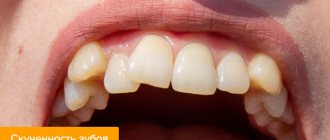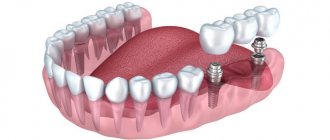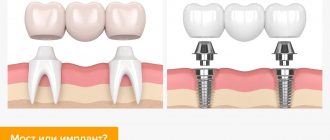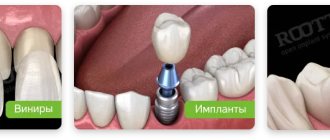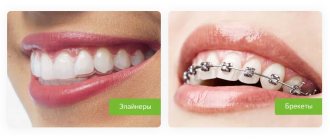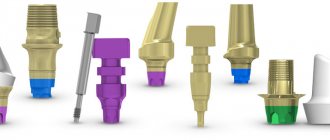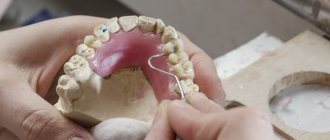Dental implants or bridges are used to restore lost teeth. Both options are functional and aesthetic. However, there are significant differences between them. To fix the bridge, the units adjacent to the defect are depulped and ground down. Due to improper load distribution, they gradually collapse and the jawbone atrophies. For an implant, these problems are eliminated. It is implanted into the jaw without the use of healthy teeth and prevents bone loss. When choosing a method, the patient should focus not only on finances, but also on long-term results.
In the photo - a dental bridge (left) and an implant (right)
What are bridges and dental implants?
A bridge is a permanent dental prosthesis consisting of crowns welded together, the outermost of which are fixed on previously ground living teeth. Used to restore 1-4 missing units in a row. The number of support units is always two. Bridges are usually created from the following materials: metal ceramics, zirconium dioxide. We install only metal-free structures.
Dental implants are artificial analogs of tooth roots that act as supports for individual crowns or dentures. Manufactured from medical titanium, biocompatible with oral tissues. Indicated for single, partial and complete edentia. They are implanted into the jaw using the following methods: classic, express, simultaneously with tooth extraction. They fully restore the functions and aesthetics of the dentition.
What is a dental bridge
A bridge is a non-removable orthopedic structure consisting of several artificial crowns. It allows you to restore a segment of missing dental units from 1 to 3 in a row. For fastening, two supports are required, which are your own teeth. Therefore, if the outermost units are lost (end defect), bridge structures are not used.
A classic bridge is a frame in the form of several crowns made of metal or precious alloys, coated with a layer of ceramic or plastic, or metal-free - ceramic or zirconium. The two outer crowns are hollow - they cover the supporting units. In order to hermetically fix the orthopedic structure, the supports are first depulped and ground, giving them a cone-shaped shape. The bridge is attached to the teeth with dental cement. It is impossible to remove the structure without damaging it.
Many specialists prefer not to tell their patients about the real disadvantages of classical prosthetics. The main one is the inability to stop the processes of bone tissue atrophy under the bridge. During implantation, not only the crown part is restored, but also the root. The jaw bone, acquiring its usual load, activates the processes of natural regeneration. Bone recession stops, and tissue volume is gradually restored.
Pros of the methods
If we compare both options, then both the bridge and the implant are non-removable structures, matched to the color and shape of the patient’s natural teeth, and restore the functionality of the dentition. However, each method has individual advantages.
Pros of bridges on your teeth:
- shortened treatment periods;
- minimum contraindications;
- affordable price.
Advantages of implants:
- functional, aesthetic;
- allow you to restore any number of lost units;
- suitable for restoring terminal defects of the dentition;
- prosthetics with single crowns, bridges and complete dentures;
- have increased stability;
- distribute the load evenly, protect the jaw bone from resorption;
- crown replacement is performed without removing the titanium root;
- have a lifetime service life (for Nobel Biocare models).
The main advantage of implants compared to classic bridges is that to install the prosthesis, it is not necessary to grind down the units adjacent to the defect.
Pros of installing an implant
During implantation, the artificial root serves as a support for the crown. Most often, high-strength titanium is used, which ensures complete inertness. This eliminates the risk of rejection and allergic reactions. Implants fully perform the functions of teeth: they restore chewing efficiency, are responsible for uniform load on the jaw bone, and maintain the shape of the gums. The appearance of an artificial neighbor does not affect the units located nearby, since titanium structures are implanted into the jaw bone, after which a crown or bridge is installed on them.
- reliability, strength, durability of structures;
- over time, bone tissue does not atrophy;
- no need to remove pulp from adjacent units;
- With proper care they can last a lifetime.
- relatively high cost;
- the presence of contraindications (diseases of the circulatory system, oncology, HIV, decompensated diabetes mellitus, diseases of the immune and endocrine systems, scleroderma, lupus erythematosus, etc.);
Contraindications
Among the limitations to classical bridge prosthetics:
- diseases of periodontal tissues (periodontal disease, periodontitis);
- serious malocclusion;
- pathological abrasion of enamel;
- inflammation of the oral cavity;
- osteoporosis and other diseases of the jaw bone tissue.
Dental implants are contraindicated in the following cases:
- high blood pressure;
- blood diseases;
- malignant neoplasms;
- diseases of the cardiovascular, endocrine, nervous systems;
- uncompensated diabetes mellitus;
- mental disorders;
- HIV AIDS;
- tuberculosis;
- infectious processes in the body;
- gum disease;
- age up to 16 years.
Implantation is also not performed in case of relative contraindications - lactation and pregnancy in women, if the patient has bad habits (smoking, alcohol abuse, drug use).
Pros and cons of implantation
The ideal orthodontic design is created taking into account high aesthetic parameters, especially for the front teeth. And first of all, its functionality must be taken into account. So, an artificial rod with a crown is precisely the only system that meets these requirements. It is tightly fixed in the bone, which prevents atrophy of hard tissues, withstands good chewing load, does not negatively affect the aesthetic properties of the gums, and looks like a natural tooth.
With careful care, a titanium rod will serve patients for a lifetime. And the crown, unfortunately, has to be changed after ten to fifteen years. The bone tissue is loaded evenly and correctly, which prevents loss of its volume, which bridges cannot do. It is worth considering that the absence of a unit for a long time causes displacement of neighboring organs. And then, when installing the rod, it will be necessary to build up the bone and turn the bent unit. This situation is fraught with changes in the oval of the face and bite, drooping of the corners of the lips, the appearance of nasolabial folds, not to mention problems with chewing food. Therefore, to avoid all this, consult a doctor on time!
The ideal aesthetic effect is achieved by working not only with hard tissues, but also with gingival tissues. Removal of the units is usually combined with the placement of an artificial rod. This preserves the shape and color of the soft tissues. More detailed information can be found at the link Single-stage dental implantation. In this case, the patient should not have inflammation, but there should be sufficient bone volume. In such a situation, neighboring healthy teeth will not be harmed in any way. Another advantage is that it is possible to restore not only single teeth, but also the jaw with general edentia. Only a few rods are implanted, and that is enough.
As for the shortcomings, there are practically none. True, there are contraindications. The ban applies to patients with severe cardiovascular diseases, serious diseases of the blood, liver, and connective tissue. The procedure is not prescribed for clients with thyroid pathology, mental disorders, allergies to antiseptics and antibiotics. Implantation is not performed if you are taking bisphosphonates systematically, which affect bone structure. But there is good news: in modern dentistry, the list of prohibitions depends on the installation technology.
Possible complications
After installing the bridge, the patient may encounter the following problems:
- sensation of a foreign body in the mouth in the first 5-7 days;
- pain (if you have this symptom, we recommend that you consult a doctor);
- food getting under the prosthesis (in case of improper fixation of the structure);
- peeling off crowns (occurs with bruxism in a patient);
- exposure of the neck of the supporting unit.
Complications after implantation occur in less than 5% of clinical cases. Among them:
- bleeding (occurs when a patient has a blood clotting disorder);
- pain (in the first 5-7 days this is a normal reaction to surgery, after this period it is a reason to consult a doctor);
- seam divergence;
- perforation of the bottom of the maxillary sinus;
- damage to the mandibular nerve (accompanied by numbness);
- peri-implantitis (inflammation of the gum tissue around the implant);
- design rejection.
Comparison of methods by characteristics
Prosthetics on implants and a bridge have a number of fundamental differences. Each technique has advantages and disadvantages. The doctor chooses the technology after assessing all factors.
Advantages
Implants are able to withstand increased chewing loads, distributing them evenly across the jaw, due to this they are not destroyed during operation. Unlike classic bridges on your teeth, which require systematic re-cementing, implants are implanted once and for life.
In the case of classic bridges, the load falls on the supporting teeth. This can lead to their gradual destruction and removal. The size of the prosthesis will increase until there are no units left to act as support. At the site of the defect, bone tissue atrophy will continue. Implantation solves this problem.
Flaws
The main disadvantages of implantation include:
- high cost - but considering that implants are installed for life, the costs are justified;
- many contraindications - currently the list of contraindications has decreased, new technologies have been developed;
- treatment period (if a two-stage protocol with delayed loading is used, accompanied by osteoplastic intervention) - one-stage technologies will allow you to restore the dentition in 1-3 days.
Installation of a bridge requires the preparation of two supports. It’s sad if you have to injure healthy units. Due to the uneven redistribution of mechanical load, bone tissue atrophy accelerates, the contour of the gum changes and sags. A gap appears between the bridge and the gum where bacterial plaque and food particles accumulate. Not all prosthetic structures are subject to repair and relocation. Teeth under crowns are subject to secondary caries, which will lead to rapid tissue destruction and an increase in the length of the defect.
Contraindications
Implantation is a surgical procedure with some contraindications. But unlike the classic bridge, a number of protocols can be used for serious periodontal pathologies, problems with bite, occlusion, and a complicated medical history.
Both methods are contraindicated in:
- inflammatory process of the oral cavity;
- infections in the acute stage;
- chronic diseases in the stage of decompensation.
Absolute contraindications to implantation include oncology and severe bleeding disorders. A bridge is not installed in cases of terminal and long-term defects (loss of 4 units in a row or more), malocclusion pathologies, or low height of dental crowns.
Possible complications
The survival rate of implant structures is 98-99.9%. But in rare cases, complications are possible - peri-implantitis (inflammation of the tissue around the implant), rejection of the artificial root. Engraftment of the implant structure requires the professionalism of the doctor and the patient’s compliance with the instructions in the postoperative period and beyond.
After installing a bridge structure, the neck of the supporting teeth may be exposed due to subsidence of the gums. With bruxism, restorations may fall out of the prosthesis. Due to improper redistribution of mechanical load, the bridge wears out faster, the supports under it become loose and shift.
Life time
The manufacturer indicates the service life of the implant is 20 years or more. With proper care and regular dental care, an artificial root will last a lifetime . An orthopedic structure installed on implants requires replacement no earlier than after 10-25 years (structures made of zirconium dioxide - 20 years and above).
The service life of a dental bridge, due to rapid wear due to bone subsidence, averages 6-10 years (depending on the material).
Price
When considering the question of what is cheaper, a bridge or an implant, we focus on the long term.
- Installing a metal-ceramic bridge of three artificial crowns costs 20-25 thousand rubles. per unit , zirconium - 40-60 thousand rubles per unit . Preparation is paid separately - depulpation of 2 support units costs 10-18 thousand rubles.
- Installation of a classic ROOTT implant on a turnkey basis costs 28 thousand rubles. , plus a metal-ceramic crown 28 thousand rubles. (zirconium - 35 thousand).
The final price of prosthetics is not too different. Considering that the bridge will have to be re-cemented every 6-10 years, which may require treatment and restoration of supporting units, implantation will allow for a more cost-effective restoration of the dentition.
Implants are a profitable solution
Classic bridge prosthetics is less expensive than implantation. However, if you take into account the costs of depulping the supporting units before installing a bridge and the need to replace the prosthesis every 7 years (in the best case scenario), implants are a profitable solution. Titanium roots do not destroy healthy teeth and have a lifetime service life, and zirconium dioxide crowns will not require replacement for at least 20 years.
Levin Dmitry Valerievich
Chief physician, Ph.D.
Advantages of implants
In modern European countries, implantation systems are considered the priority type of prosthetics. This type of treatment is used even in cases of large or complete absence of teeth.
In developed European countries, a doctor does not have the right to offer a patient the installation of a bridge where it is possible to install an implant. Otherwise, he will be deprived of his license to engage in private practice.
Unlike bridge structures, implant systems completely restore the function of missing teeth (front and chewing) and meet the high aesthetic requirements of patients.
Also, the advantages of installing implants include:
- the possibility of their long-term use (often a lifetime guarantee) due to the presence of strong artificial roots made of titanium alloy.
- fast prosthetics – most often the whole process takes up to 2 months, and sometimes modern implants are installed in one stage immediately after tooth extraction;
- the ability to do without turning and depulping, keeping the abutment teeth unharmed;
- ideal distribution of food load on the gingival bone, comparable to natural and the ability to protect the gums and jaws from atrophic changes;
- the ability to select a crown with a full selection of shades to match the natural color of the patient’s tooth enamel;
- excellent survival rate of structures (96-98%) due to the use of hypoallergenic materials;
- the possibility of using implants as a support for fastening for clasp and bridge-like removable structures.
It is important to install an implant as soon as possible after tooth loss. This helps keep the dentures from sagging and forget for a long time about the issues associated with repeated prosthetics.
What is better to put on the front teeth?
Implantation is the best option when restoring anterior units. This is due to increased demands on aesthetics. The bridge initially corresponds to them, but gradually, due to atrophy of the jaw bone, it sags, becomes mobile, and a gap appears between it and the gum. The implant, on the contrary, preserves the healthy appearance of the gums and compacts the surrounding bone tissue. As part of the classical installation method, the formation of the correct gingival contour is additionally carried out. Aesthetics do not deteriorate throughout the entire service life of the structure.
Indications for installation of bridges
Let's look at situations where it may be recommended to replace missing teeth with bridges. Such indications may include:
- absence of teeth (one or more);
- financial difficulties that do not allow the patient to use dental implants;
- chronic diseases or conditions in which implantation is contraindicated (dystrophy of the jaw bone, pathology of the oral mucosa, general chronic diseases, etc.).
The main advantage of replacing missing teeth with bridges is that they are cheap and accessible to people of low income. However, due to a host of shortcomings, bridges are gradually giving way to more advanced types of prosthetics.
What to choose for a chewing tooth
In this case, the bridge and the implant have their own advantages and disadvantages. A bridge allows you to quickly restore the functionality of the dentition and cope with the chewing load normally. However, uneven distribution of pressure gradually leads to destruction and removal of supporting teeth.
The implant does not have a destructive effect on neighboring units; in all respects it is identical to a natural tooth. However, when installing a titanium root in the masticatory region, loading with a full-fledged prosthesis is not allowed until the artificial root has completely engrafted.
What are implants
Implants are considered the most modern and reliable way to replace missing teeth. Although this method is not cheap, thanks to it you can forget about dental problems for a couple of decades.
The implant itself consists of three main parts: a crown (fixed on a pin), an abutment (the junction of the upper part of the prosthesis and the root) and an artificial root (usually made of titanium alloys).
Typically, patients resort to installing implants in the following cases:
- in the absence of contraindications;
- if you do not want to install removable dentures;
- wanting to do without grinding the supporting teeth.
Most often, modern orthodontists advise their patients to install screw implants. This model is a type of screw that is screwed into the jawbone as a base for attaching a crown.
Most often, a patient receives as many implants as there are missing teeth. When using implants, bridges are very rarely used as a basis for crowns. This happens because an ordinary tooth is attached to the socket with the help of ligaments, which provide it with the necessary mobility. An artificial implant is firmly fixed and has no natural mobility. Therefore, each such non-removable structure is attached to its own separate hole, helping to properly distribute the food load and without injuring the jaw bone.
Clinical cases
- If one tooth is missing . When restoring a single defect, the condition of neighboring units is taken into account. If they are healthy, it is better to choose implantation, since bridge prosthetics involves depulping the supporting teeth. If they are already pulpless, you can install a bridge.
- If several teeth are missing in a row . The choice of method depends on the extent of the defect. A bridge can restore no more than four missing teeth in a row. Implants - any quantity. In this case, it is not necessary to place a separate rod in place of each lost unit. There are options to fix a smaller number of titanium supports and cover them with a bridge. A bridge on implants does not destroy healthy teeth, the load is distributed evenly, and jawbone loss is eliminated. Plus treatment is cheaper.
- End defect . If the outermost teeth in a row are lost, the only option is implantation, since to fix the bridge at the edges of the defect there must be two supports.
Disadvantages of implants
As with any treatment method, even the most modern and popular, the implantation method also has disadvantages. These include:
- a large number of different contraindications;
- high cost and inaccessibility for patients with low incomes;
- long stages of implantation, lasting up to a year.
Installing implants requires contacting qualified and skilled specialists. In this case, the dentist must thoroughly examine the patient and think through a treatment plan.
Successful implantation of the structure requires strict adherence by the patient to all instructions and prescriptions of the specialist doctor. This will avoid dangerous postoperative complications.
What is better - dental implantation or bridge?
For a clear example of the strengths and weaknesses of both options, we provide a comparative table.
| Bridge | Implant | |
| Number of missing teeth | 1-4 | any quantity |
| Degree of mastication recovery | average | full identity to a natural tooth root |
| Aesthetics | average | high |
| Recovery time | up to 1 month | 4-6 months, with bone grafting - up to 1 year |
| Difficulty of installation | average | complex |
| Impact on adjacent teeth | subject to depulping and turning | are not used |
| Jaw bone loss | intense | absent |
| Reliability of fixation | mobility of supports is possible in case of diseases and inflammation of periodontal tissues | complete immobility |
| Difficulty of care | Difficulties arise when food gets under the prosthesis | does not require special care |
| Restrictions on food intake | increased load excluded | any load is allowed |
| Comfort while wearing | There is discomfort in the first days after installation | complete comfort |
| Life time | up to 7 years, depending on the condition of the support units | implant - for life, prosthesis - 15 years or more |
| Price | Average | High |
Our dentists recommend that patients do not delay the restoration of missing teeth. Without load, the jawbone begins to atrophy. The method of filling a gap in the dentition must be decided quickly. Each patient, taking into account his financial capabilities, makes his own decision - whether it will be a bridge or an implant.
What is an implant?
An implant is a multicomponent structure that includes a pin, an abutment and a crown. The pin is a titanium rod that resembles in shape and replaces the root of a tooth. When implanted, it is implanted into the bone tissue in place of the missing unit in the row. After several months, the rod is completely engrafted: it fuses with the bone. Next, the abutment is screwed into it, which is the connecting link between the implant and the crown. The visible part allows you to completely restore the chewing and aesthetic function of the tooth. The crown looks like a natural unit, as it is as close as possible to it in enamel shade and shape.
Restrictions on installing an artificial root
Implantation is indicated when a person is missing one or more teeth and there is significant destruction of the nearest ones. Dentists also advise installing artificial roots in cases where the patient is categorically against grinding down adjacent teeth. It is recommended to install an implant in cases where it is not possible to install a bridge.
Crowns should be placed in situations where:
- There is no protective layer of the tooth;
- Increased abrasion is observed;
- Most of the tooth is damaged by caries.
A crown differs from an implant in that the latter can be used to restore a lost tooth, while the former helps preserve a damaged one. The doctor chooses what is the best option in each specific case.
There are a number of absolute contraindications for installing an artificial root:
- Various neoplasms;
- Diabetes mellitus in a severe stage of development;
- Tuberculosis;
- Disturbances in the functioning of the nervous system;
- Various mental disorders;
- Blood diseases;
- Inflammatory diseases of an infectious nature, localized in the area of the mucous membranes of the mouth;
- Weakening of the immune system;
- Exacerbations of various chronic diseases.
When placing an implant, the doctor must take into account the condition of the hard tissues of the jaw and their integrity. If the last point is violated, an artificial root cannot be installed.
There are also a number of relative contraindications for implantation of a metal pin:
- Pregnancy, breastfeeding;
- Insufficient compliance with hygiene measures;
- Bite disorders, congenital jaw defects;
- Inflammatory processes in the gums;
- Excessive smoking, alcohol abuse.
When deciding to install a titanium root, you should take into account all these contraindications and consult with an experienced specialist. Only after all possible risks have been eliminated is prosthetics using a pin possible.
Zirconium dioxide dental bridges –
Zirconium dioxide ceramic bridges are manufactured using CAD/CAM technology, which involves milling bridges from pressed zirconium dioxide blocks on a computer-controlled machine. Sintered zirconium dioxide has a strength comparable to metal (more than 900 MPa). Thanks to this, zirconium dental bridges can be made of any length - even horseshoe-shaped bridges with a length of 12-14 teeth (which cannot be made from any other types of metal-free ceramics).
We have already said above that a zirconium bridge is the gold standard for prosthetics of the chewing group of teeth. But there are questions about the aesthetics of zirconium dioxide bridges, and when prosthetizing the front teeth, you may encounter a big problem (the bridge will stand out against the background of the patient’s own teeth). The fact is that there are 2 types of bridges and crowns made of zirconium dioxide, and they differ from each other not only in aesthetics, but also in the risk of ceramic chips.
1) “Traditional” zirconia bridges –
For such bridges, only the internal frame will be made of zirconium dioxide, which is lined with ceramic mass, or rather porcelain, on the outside (Fig. 14). And this is due to the fact that most dental laboratories use cheap versions of zirconium dioxide blocks. This zirconium dioxide has a bright white color, plus it is completely opaque, and as a result, such a material does not allow achieving a certain degree of translucency, which is characteristic of natural tooth enamel.
Crowns and bridges made from such material will have an unnatural milky white color, plus there will be no translucency characteristic of natural teeth. Therefore, in order to improve aesthetics, only the internal frame is milled from such zirconium dioxide, which gives strength to the structure, and then the dental technician, by applying layers of porcelain, gives the crowns of the bridge the final shape and color. But even despite this, the aesthetics of such crowns and bridges will be far from perfect.
Plus, this manufacturing method has another disadvantage. We have already said above that zirconium dioxide has the strength of a metal (from 900 MPa), however, the layer of porcelain mass on the surface of the zirconium frame has a strength of only 80-120 MPa. This leads to chips of the ceramic mass (according to statistics, within 6 years they occur in approximately 10% of patients). The chips are repairable, but the reliability of such repairs leaves much to be desired.
Conclusions : we do not recommend using zirconium dioxide bridges (made with a surface layer of porcelain) for prosthetics of chewing teeth, because in this case there will be a high risk of chipping. When replacing front teeth with prosthetics, this option is not very successful, because the crowns of the bridge will still have an unnatural milky tint, standing out against the background of your own teeth (Fig. 15-16). Plus, there is still a risk of chipping the porcelain lining.
The aesthetics of such structures are
Such milky-white crowns and bridges made of zirconium dioxide will look acceptable only in one case - if you are going to simultaneously prosthetize all the teeth that fall into the smile line on both the upper and lower jaws (i.e. at least the fifth teeth inclusive ). Otherwise, such a bridge will be very noticeable against the background of your own teeth.
2) Zirconium bridges using “Multi-layer” technology –
But the problem of poor aesthetics and chipping was solved by the advent of the next generation of zirconium dioxide blocks/discs. Currently, a number of manufacturers produce zirconium dioxide with “Multi-layer” technology. Discs made from such zirconium dioxide are “pre-colored”, i.e. they have a color gradient that is characteristic of the enamel of real teeth. The second difference: due to the stabilization of zirconium dioxide by yttrium, such blocks will have varying degrees of “transparency”, i.e. translucency.
As a result, crowns and bridges made from such material will have a gradient of color and transparency, which will vary from the neck of the tooth to the incisal edge (the cusps of the chewing teeth). Those. The closer to the incisal edge, the lighter and more transparent the zirconium dioxide becomes. But multi-layer technology can provide more than just good aesthetics! In this case, there is no need to use surface layers of porcelain, and therefore crowns and bridges will be made of monolithic zirconia.
Clinical case No. 1 – below you can see the aesthetics of newly made single crowns and bridges made of zirconium dioxide, made using the “Multi-layer” technology (they are not yet fixed in the oral cavity, but are on a plaster model of the patient’s teeth). The bridge prosthesis in the projection of 14-15-16 teeth is made with artificial pink gum, and the remaining units are made in the form of single zirconium crowns. With these photos we want to show a smooth transition of color and transparency.
Therefore, if you want to get decent aesthetics, then when you go to a dental clinic, you need to find out whether they use “Multi-layer” zirconium dioxide. High-quality discs using this technology: these are 2 variants of Katana® discs - UTML or STML (Japan), as well as Prettau® Anterior (Germany). The cost of one such disk starts from 16,500 rubles. For example, a disc made of ordinary white opaque zirconium dioxide costs only 4,500 rubles, and therefore many clinics, in an attempt to save on costs, work with cheap, outdated materials.
Conclusions: if you need a bridge prosthesis on implants, or a bridge prosthesis in the area of chewing teeth, then a bridge made of monolithic zirconium dioxide using the Multi-layer technology is not the cheapest, but the best option. When it comes to front teeth prosthetics, if you want to get the best aesthetics possible, there are limitations. For example, if you are planning to make a bridge or crowns on all front teeth (falling into the smile line), then Multi-layer zirconium dioxide will allow you to get the ideal aesthetic result.
However, if you need a bridge for only 3-4 teeth, then even with the help of the Multi-Layer technology, a dental technician is unlikely to be able to make such a structure absolutely indistinguishable from neighboring natural teeth. In this case, to achieve ideal aesthetics, it is worth choosing a bridge not from zirconium dioxide, but from pressed Emax ceramics. This is due to the fact that when working with Emax, the dental technician will have significantly more color options in his arsenal (than when working with any option of zirconium dioxide), which will make the bridge as similar as possible to the neighboring teeth.
Cost – for zirconium bridges, the price for 2022 in Moscow will be on average from 30,000 to 40,000 rubles (for 1 Unit/crown). Thus, the cost of a 3-unit bridge will be at least 90,000 rubles. However, in a number of clinics you may well be offered a price of less than 30,000 per unit, but in this case the bridge will clearly not be “multi-layer” or monolithic.
What types of dentures are there for damaged teeth?
It often happens that the crown part of the tooth begins to collapse, but the root is completely healthy and sits firmly in the gum. In such cases, dentists do not recommend removal, because the root can be preserved and the crown part can be replaced with prosthetics - this is a more gentle and beneficial method for the patient to restore the defect. What dentures are available for such cases? There are several types of so-called microprostheses that will help restore the integrity of the dental crown:
- Tabs.
Simply put, these are large fillings made of ceramic or metal alloys that are made in a laboratory. The inlays exactly repeat the shape of the destroyed part of the crown and can serve as both an independent microprosthesis (restorative inlays) and a support for an artificial crown (stump). - Crowns.
The crown is the part of the tooth that we usually see and on which both the beauty of a smile and the quality of chewing food depend. Dentists install artificial crowns that cover the damaged tooth and completely cover the defects. They are made from metal-free ceramics (excellent aesthetics, good strength), metal ceramics (good strength and aesthetics) and plastic (suitable only for making temporary crowns, because such material is not very durable and stains over time). - Veneers.
For teeth in the “smile zone,” it is possible to install not entire crowns, but thin ceramic overlays on the front surfaces – veneers. They are installed if sufficient volume of the rear wall has been preserved and the microprosthesis can be securely fixed. Veneers are made from ceramics, and recently there are also designs made from zirconium dioxide. The simplest and most inexpensive option is composite veneers, formed from filling material directly on the patient’s teeth.
Orthopedic dentist at the 32 Dent clinic Veronika Aleksandrovna Ivantsova: “Microprostheses are good because they can restore both small defects (mainly veneers and lumineers) and seriously damaged teeth. We recommend our patients to fight for their own teeth to the last and, if possible, to preserve the dental unit - in no case to remove it.”
Which dentures are best to install: choose by cost
The most affordable microprostheses are inlays - they cost from 18,000 rubles. However, it is not always possible to get by with just one tab, so it is advisable for the patient to make a choice, guided not only by savings, but also by the advice of his doctor.
Veneers with lumineers will cost approximately the same - about 20-35 thousand rubles. Crowns differ slightly in price depending on the material: metal-free ceramics will cost about the same as a veneer, metal ceramics will cost 9-17 thousand rubles. Here you should choose according to the degree of destruction of dental tissues: if the defects are minor, you can get by with installing veneers. But in the case where the crown part of the tooth is seriously damaged, the installation of an artificial crown will be required.
If you have a problem similar to that described in this article, be sure to contact our specialists. Don't diagnose yourself!
Why you should call us now:
- We will answer all your questions in 3 minutes
- Free consultation
- The average work experience of doctors is 12 years
- Convenient location of clinics
Single contact phone number: +7
Make an appointment
Which teeth are best to insert in case of multiple defects?
If you had to part with several teeth at once, you can restore each of them separately with implantation. To do this, you will have to be patient, because implants need about six months for final engraftment. But the result is worth it: at least for the next 20-30 years, you can forget about prosthetics. If financial capabilities and the condition of the body allow, you can opt for implantation. But there are other options, simpler and less expensive:
- Bridges.
They can restore up to 3-4 missing teeth in a row. - Clasp dentures.
This is one of the varieties of removable structures, which consists of a plastic gum base with crowns attached to it and a metal arch, which is the frame. The clasp is attached to the supporting teeth using hooks (clasps), clasps (attachments) or telescopic crowns. If necessary, it can be easily removed and just as easily installed back. - Removable dentures
. The simplest designs to install, which, however, are inferior in functionality and wearing comfort to both bridge and clasp prostheses. What types of removable dentures are there? They can be nylon - softer and more elastic, or acrylic - tougher, better able to withstand chewing loads. The first ones are more comfortable, the second ones are more functional.
Which dentures are the best in price?
When a patient chooses which dentures are best, they often look for price. You already know the cost of bridge structures, removable ones will cost about 15 thousand rubles, clasp ones - 30-60 thousand rubles with fastenings on clasps or attachments and 60-120 thousand rubles with fastening on telescopic crowns.
What to choose, removable or partially removable dentures – which is better? If you focus only on cost, then the first ones certainly win. But in terms of durability, wearing comfort and functionality, the latter are the leaders.
Removable dentures: the fastest and cheapest way to replace teeth
Removable dentures are products with a soft or hard base that imitates the mucous membrane of the oral cavity, and artificial teeth. They can be partial or complete, that is, replace a segment of the dentition or the entire jaw. A partial removable denture has special hooks - metal made of clasp wire (clasp-based denture) or plastic, which cling to the teeth, and a complete removable denture is fixed in the oral cavity due to the valve zone.
It is believed that removable dentures are now hopelessly outdated, but they have their advantages, thanks to which this solution is still in demand.
A)
Perhaps their most important advantage is the price. The cost of a removable denture depends on the material and the number of teeth being restored, however, even the most expensive removable denture costs several times less than a similar design on implants.
b)
Typically, such prostheses are manufactured within 2 weeks and do not require surgical intervention, unlike implantation. It is no secret that most patients try to avoid any surgical interventions and often choose removable dentures for this very reason.
c)
If 40-50 years ago removable dentures did not look very natural, then modern solutions (silicone removable dentures, orthopedic structures using composite teeth and individual options for coloring the base of a removable denture) can satisfy even the most demanding patient.
Possibility of complications after surgery
Some complications appear both at the stage of implant installation and during its engraftment. Most often, the patient may encounter the following problems:
- Pain, which is a normal reaction of the nervous system to surgery, lasts no more than three days;
- Swelling is considered a tissue response to damage; after a week, swelling should go away if you take antibiotics and follow your doctor’s recommendations;
- Impaired sensitivity, which manifests itself as a result of nerve damage or increased blood flow to the damaged area, rarely such a phenomenon manifests itself as a residual effect of anesthesia;
- Bleeding, which is considered normal within three hours from the moment of surgery, as blood vessels are damaged when making an incision;
- Suture dehiscence occurs when the operated area is injured and can result in infection and blood poisoning;
- A hematoma occurs at the site of severe damage to soft tissues and goes away on its own over time;
- Mechanical damage to the naso-palatal bundle due to incorrectly selected length of the pin rod;
- Damage to the neurovascular bundles, which can lead to serious problems with the soft tissues of the jaw;
- Rejection is rare and occurs against the background of an inflammatory process in the body.
If the implant is tightened by hard tissues or installed at an angle, then this significantly complicates further prosthetics. It will take a long time to get used to such a pin.
If a patient is thinking about whether a crown or an implant is better, then the choice should be made on the latter, at least due to its long service life. Most dentists guarantee that such dentures will last almost a lifetime, without requiring replacement or repair. But the service life of any implant will depend on the professionalism of the dentist and on the correct installation of the pin. The patient should carefully care for the implant to extend its service life.
